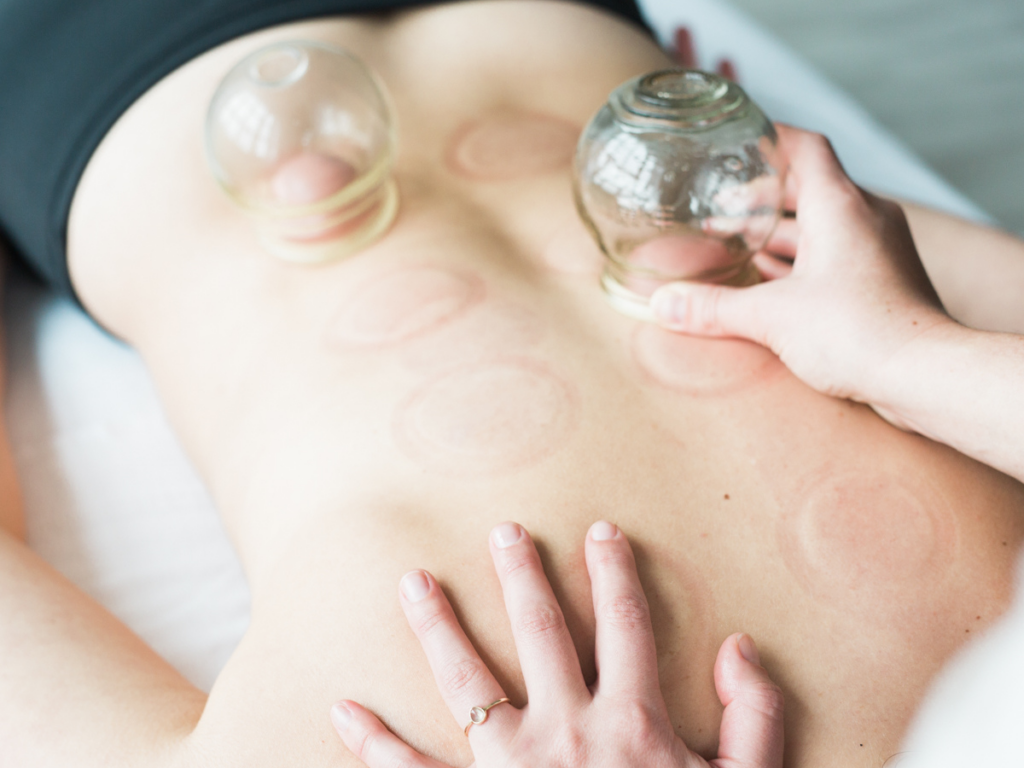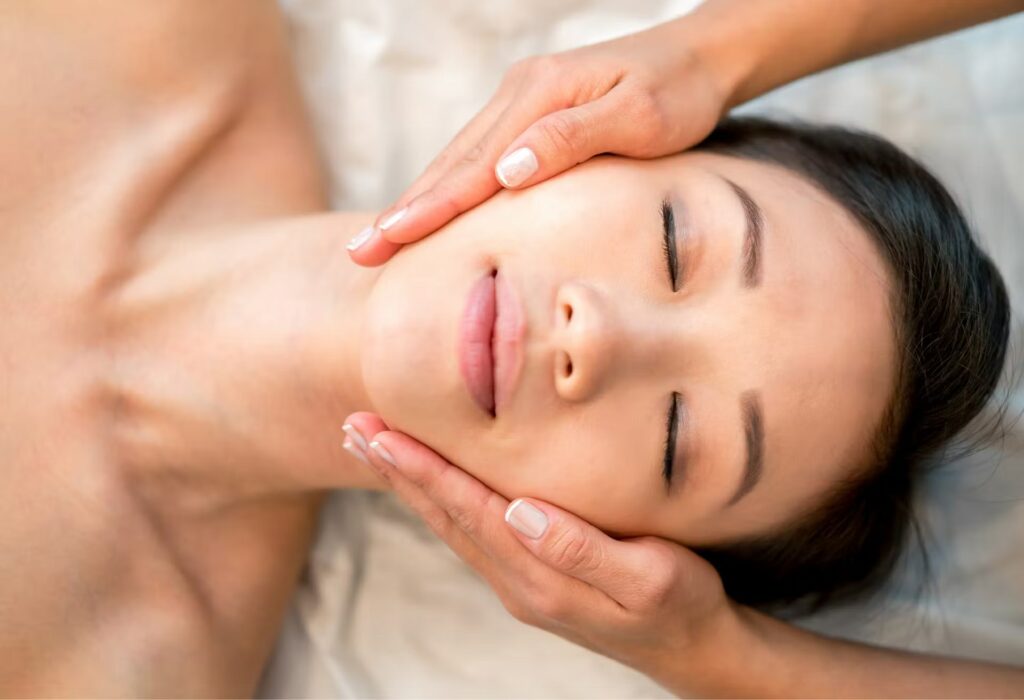Cupping therapy, embraced by athletes, celebrities, and wellness enthusiasts alike, offers a natural and effective way to release toxins from the body.
This ancient practice has gained modern recognition for its ability to address inflammation and provide profound relief, and the research supports these findings.

How Cupping Works: Understanding the Mechanisms Behind its Therapeutic Effects
Creating Suction and Enhancing Circulation:
At the heart of cupping therapy lies a masterful interplay of suction and your skin. The placement of cups – usually crafted from glass, plastic, or silicone – on specific body zones generates a vacuum effect. This process wakes up your blood vessels, capillaries, and lymphatic system, bolstering circulation in the targeted area. This surge in blood flow carries life-giving nutrients, oxygen, and immune cells to the site, fueling healing and combating inflammation.
Microtrauma and Controlled Inflammatory Response:
Applying these cups sets off a chain reaction of controlled microtrauma in the underlying tissues. This minor shock sparks an inflammatory response, a crucial player in your body’s natural healing choreography. This leads to the body releasing a flurry of chemical signals and immune cells to the cupped area, enhancing tissue repair and regeneration. This clever orchestration of inflammation helps alleviate pain, swelling, and inflammation linked to a range of conditions.
Release of Tension and Stagnation:
Cupping therapy is a master key to unlocking tension and stagnation trapped within muscles and connective tissues. The vacuum effect hoists these tissues upward, providing a gentle stretch and separation. This action dissolves adhesions, elevates muscle flexibility, and fosters energy and fluid movement throughout your body. Cupping therapy can soothe muscle pain, boost range of motion, and restore harmony to your body’s symphony of systems by freeing up tension and stagnation.
Stimulating the Nervous System:
Cupping therapy isn’t just about physical relief; it’s a love letter to your nervous system. The suction incited by the cups wakes sensory receptors within the skin, firing up the nerves and setting off a cascade in the central nervous system—this domino effect ushers in the release of endorphins, your body’s personal pain-busting and mood-lifting squad. Consequently, cupping therapy can guide you into a haven of relaxation and uplift your overall well-being.

Championing Lymphatic Drainage and Detoxification:
An unsung hero of cupping therapy is its prowess in supporting lymphatic drainage and detoxification. The suction summoned by the cups triggers the flow of lymphatic fluid, your body’s diligent waste disposal and detox service by championing lymphatic drainage, cupping therapy rallies behind your body’s inherent detox abilities, aiding in the purge of harmful substances and propelling your wellness journey forward.
Understanding Cupping Therapy and Connective Tissues:
Let’s delve into the specifics of cupping therapy and its remarkable interaction with the body’s connective tissues. Like a city’s infrastructure, these tissues support and interconnect diverse structures within the body, contributing to its overall functionality.
In a cupping therapy session, strategically applied cups—often fashioned from glass, plastic, or silicone—are placed in designated areas of the body, usually fascial meeting points or insertion points of muscles.
The fascinating mechanism behind cupping occurs when these cups create a vacuum effect, generating a suction on the skin and underlying tissues. Consider this suction as a delicate activation of your connective tissues. It mobilizes them, allowing them to stretch. This physical manipulation, reminiscent of a refreshing stretch, enhances flexibility and range of motion at the tissue level and fosters an influx of beneficial elements. This therapeutic practice facilitates the flow of vital nutrients, oxygen, and immune cells by stimulating the blood vessels and capillaries in the cupped area.

Despite its gentle nature, cupping therapy is astoundingly effective. It combats the discomfort associated with inflammation in connective tissues—your body’s alarm signal indicating injury or disorder. By relieving this inflammation, cupping therapy facilitates an internal healing process, offering a natural, non-invasive form of relief. This unique characteristic makes it an attractive alternative or supplement to traditional medical treatments.
In conclusion, cupping therapy’s targeted interaction with the body’s connective tissues can significantly improve our overall health and well-being.
Exploring the Types of Cups Used:
Cupping therapy utilizes a variety of cup types, including glass, plastic, or silicone cups. Each type offers unique benefits and allows practitioners to customize the treatment according to individual needs. Glass cups are traditionally used in Chinese cupping therapy. At the same time, modern innovations have introduced plastic and silicone cups that provide flexibility and ease of use.
The Vacuum Effect: A Reverse Massage:
One of the core mechanisms of cupping therapy is the vacuum effect it creates. Like a reverse massage, the cups are applied to the skin, creating suction that draws the underlying tissues upwards. This action helps stimulate blood circulation, relax muscles, and release tension and stagnation. The resulting therapeutic effect aids in reducing inflammation and promoting overall well-being.
How Cupping Works for Inflammation: A Medical Perspective:
From a medical standpoint, cupping therapy for inflammation involves triggering a localized immune response. The vacuum effect created by the cups stimulates micro-trauma, leading to a controlled inflammatory response. This response mobilizes the body’s healing mechanisms, promoting the release of anti-inflammatory substances and accelerating the repair and regeneration of damaged tissues. As a result, cupping therapy can effectively reduce pain, swelling, and inflammation associated with various conditions.
Addressing Pain and Inflammation Symptoms with Cupping:
Cupping therapy can effectively address a wide range of symptoms related to pain and inflammation. Whether you experience muscle soreness, joint stiffness, or chronic inflammation, cupping therapy can provide relief. It has shown promising results in reducing symptoms associated with conditions such as arthritis, tendonitis, fibromyalgia, and sports injuries.
Maximizing the Benefits: What to Do After a Cupping Session:
After a cupping session, it is essential to take certain steps to optimize the benefits of the therapy. Hydrating adequately, engaging in light physical activity, and maintaining a healthy lifestyle can help support the body’s natural detoxification process. Additionally, applying natural topical remedies or essential oils, engaging in relaxation techniques, and following any specific recommendations from your practitioner can enhance the effects of the cupping session.





